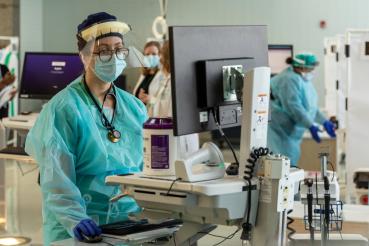Once we’ve ridden the omicron wave, what’s next? Many have assumed that SARS-CoV-2, the coronavirus that causes COVID-19, is evolving into a less dangerous virus because the now-dominant omicron variant tends to cause milder COVID-19. And while that’s generally how certain viruses evolve, they don’t always follow that pattern.
“With a respiratory virus, we expect that as the population builds immunity and the virus mutates, it usually becomes less severe over time,” says Hannah Barbian, PhD, a virologist and genomic epidemiologist who is studying SARS-CoV-2 for the Regional Innovative Public Health Lab at RUSH. “But viruses aren’t always predictable, and sometimes there can be mutations that do unexpected things.”
Detecting the next variant in Chicago
Even though it’s difficult to predict exactly how a virus like SARS-CoV-2 will change over time, scientists can still monitor when it changes. That’s what they do at RIPHL, working in partnership with the Chicago Department of Public Health and other local hospitals. Their work helps public health officials understand which variants are spreading the fastest and which communities are most affected so they can take action to reduce the spread.
Each week, scientists at RIPHL conduct genomic sequencing on COVID-19 samples collected throughout Chicago to monitor currently circulating strains and to detect new strains of SARS-CoV-2.
“RIPHL has established a surveillance strategy that is predicted to detect a new variant present in only about 2 percent of samples,” says Mary Hayden, MD, chief of the Division of Infectious Diseases at Rush University Medical Center and co-principal investigator of RIPHL. “Our team keeps track of the global emergence of new variants so that they can modify screening protocols as needed. This nimble, flexible approach gives us the best chance of detecting important variants quickly.”
What they are looking for are mutations, which is how viruses evolve. Some mutations in the genetic code make it impossible for a virus to replicate, so it cannot thrive. But other mutations can make a virus more equipped to survive. This leads to dominant variants like omicron, which is still responsible for the vast majority of COVID-19 cases in Illinois.
“We sequence viruses every single week so we have really up-to-date information on what’s present in Chicago and if that is different from other places in the country or if it’s similar,” Barbian says. During the omicron surge, variant proportions in Chicago have mirrored other parts of the country.
An offshoot of omicron?
The big question — when a new strain will arise and dethrone omicron as the dominant variant — is impossible to answer. “We can’t say with any certainty that there’ll be a new one every year or every five years,” Barbian says.
What scientists do know is that changes are already occurring with the omicron variant, which has actually split into two sub-variants: BA.1 and BA.2. BA.1 is the predominant strain, especially in the United States. But BA.2, which has a different profile of mutations, is now circulating primarily in Europe and Asia.
If BA.2 comes to Chicago, Barbian will be able to detect it with a type of test called a rapid, high-throughput PCR assay that she developed. Currently, it is unclear if BA.2, referred to as “stealth omicron” in some media reports despite being readily detected by SARS-CoV-2 diagnostic tests, behaves differently from BA.1 in terms of its severity, transmissibility or ability to resist immunity.
How variants evolve to become dominant
Why do some variants beat out others? Mutations that bestow viruses with increased transmissibility or the ability to evade pre-existing immunity can give some variants a “fitness advantage” over others, Barbian explains. In the case of SARS-CoV-2, the virus usually accumulates mutations slowly and predictably over time. “With omicron, there was clearly some other force that was impacting the evolution of the virus,” Barbian says. One hypothesis is that omicron grew in a patient with a weak immune system who had a long-lasting SARS-CoV-2 infection, which created the opportunity for the virus to accumulate a lot of mutations as it kept replicating in the body.
Another factor that can shape a virus’s evolution is animal-to-human transmission. Viruses, especially SARS-CoV-2, can infect animals besides humans. To do so, the virus has to make some adaptations so it can grow in a different species, Barbian says. For example, SARS-CoV-2 can spread easily to mink. “It often acquires some mutations in order to grow better in that animal species, and then it can transmit back to humans,” she says. The concern is that during this process, the virus might pick up some mutations so it can grow better, which can speed up the evolutionary process of the virus.
SARS-CoV-2 as a seasonal bug
Although it’s unclear how SARS-CoV-2 will evolve over the next few years, Barbian offers a hopeful prediction: The virus will eventually become less severe or seasonal or both, much like the four seasonal coronaviruses that cause about 20% of colds.
This shift will gradually happen as immunity grows around the globe. “Most of the population will have some kind of immunity through vaccination or through an infection, so if you get a new infection, you’ll likely have a milder disease,” she says. “Of course, new variants might shake that up a bit, but in general, I think that’s where we’re headed.”
Getting vaccinated and boosted can protect you against omicron and future variants. You can schedule an appointment to receive your shot now at our vaccine clinics.




